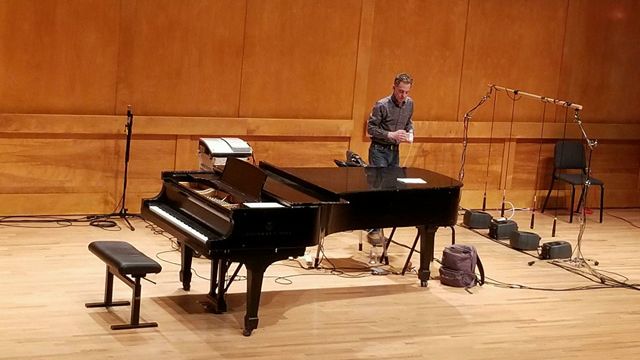Photo by Diamond Bridges
By Diamond Bridges
Listicles Editor
Four microphones hung upside down over four speakers from a metal bar on stage. They created unnatural screeching sounds as they swing back and forth in a rhythmic motion. The audience is mesmerized as they listen to the microphones swing from fast to slow melodies.
Students and professors immersed themselves in a night full of strange yet interesting sounds from typical orchestra instruments to electric mixers during Earfest this past Thursday. Stony Brook Computer Music Studios held a lecture and concert to introduce electronic and computer music and
To also showcase musicians’ creative pieces.
“I thought it was going to be like electronic dance music as opposed to just electronic because when I think of electronic music, that’s what I think of initially, so it was a completely different experience,” Jocelyn Adams, a student who attended Earfest for the first time.
“Since the 1970s this movement has been intertwined with other less academic styles, like a lot of us [composers] have an engagement with various points of improvised music,” Nicholas Collins, a composer, and lecturer at this year’s Earfest said. Collins has been a composer and performer of electronic and instrumental music for over 40 years. That night he lectured on electronic and computer music of this time and even performed with his handmade trumpet that does not give off the typical trumpet sound. His trumpet had wires connected to different parts of the instrument which allows it to create an unusual and disturbing sound like a robot.
Music and its interpretation are constantly evolving. Musicians find ways to refine and change the structure of what people associate with music. Electronic and computer music is not just violinists and percussionists sitting together in an orchestra to play a classical piece. This style of music involves electronic interaction to the instruments.
These musicians showed a new way of creating music through unconventional ways and focused on the feedback from the instruments rather than the sound the instrument was made to play. “We don’t normally hear [feedback], but if you put a speaker across from a speaker then you’ll pick up that feedback and it’s basically recording the sound the speakers are emitting,” Adams said. Four performances made up the concert, where the performers showcased different pieces that capture the essence of what electronic music is.
The concert opens up with a piece called “Pendulum Music,” composed by Steve Reich, where the audience can experience the gradual process of swinging microphones set up as a pendulum. Another performance titled “Qilyaun” composed by John Luther Adams, where the performer plays a large drum at various speeds but the frequency is affected by the electronic delay. There is also a performance called “Empty Vessels,” where two musicians play similar and sometimes different melodies on a table filled tubes, wires and cassette recorders.
“Many people think it sounds like aliens. Electronic music is new sounds and it has often been used in the movies to indicate aliens,” Margaret Schedel, an associate professor of Composition and Computer Music at Stony Brook University, said. “Computer music means I can do almost anything I can imagine in sound. I’m not limited to what a physical instrument can do.”
One piece that matches Schedel’s description of the electronic music: A woman walks on stage and sits at the black grand piano that is placed in the middle of the stage. Soon the room is filled with a very subtle and ominous sound. The woman finally places a key on the piano as the very hollow sound changes its frequency like walking through the creepy woods at night. This piece is titled, “Pea Soup,” composed by Collins, which captures the different frequency whenever the feedback builds through the electronic software and the piano.
Earfest has first introduced itself to the campus community back in the winter of 1992. “ So I started EarFest, which was originally mostly fixed media, the sound alone and sound or video, pieces,” Daniel Weymouth, an associate of Composition and Theory. “Playback in a hall, with fellow listeners around you, and on a good system, really is different than hearing it on your computer.”
Earfest allows you to surround yourself with sounds that both calm your nerves and shock your senses. The concert creates a space where the audience can be confused by the unnatural sounds that certain instruments make but at the same time can appreciate the musicians’ creative mind for taking the next step to elevate music in new ways today.


